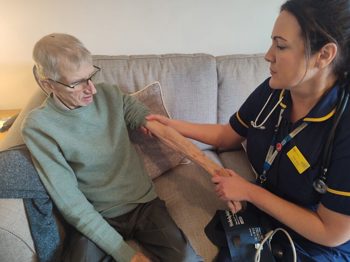Providing patients with hospital-quality treatment in the comfort of their own home
Thursday, 11 January 2024

Countess of Chester’s Hospital at Home service
When John Gore, a 73-year-old patient from Cheshire, became ill with pneumonia recently, he thought he might have had to spend the lead-up to Christmas in hospital. But thanks to the Countess of Chester NHS Foundation Trust’s Hospital at Home service, he is receiving hospital-quality treatment in the comfort of his own home this winter instead.
Mr Gore was very poorly when he was referred to the Hospital at Home team by his GP and was put on a two-hour urgent referral. The team arrived at his home within 45 minutes of the referral being made, assessed him, and started him on some IV antibiotics. The visit enabled his condition to be quickly stabilised, and prevented a hospital admission.
After already being in and out of hospital in the past for a number of health issues, Mr Gore was absolutely delighted to be able to stay at home, especially in the run up to the festive season – and for the hospital, it was also an extra bed saved for someone who needed it more.
The Hospital at Home service is one of a number of initiatives being delivered by NHS teams to help people stay in their homes – or return home as quickly as possible after a hospital stay. The service is GP-led, with a multi-disciplinary team consisting of nurses, advanced clinical practitioners, therapists and support workers, and provides a comprehensive offer to patients in their own homes, when previously they would have had to be in hospital.
The team provide several offers including a two-hour community crisis response, virtual ward care, and a home IV antibiotic service. Combining urgent community response and virtual ward enables them to provide real, joined-up care from referral to admission – making a real difference to patient outcomes.
Impact on care
In the period from August to October 2023, a total of 939 referrals were made into the service, with over 90% of those patients being able to be treated in the place they call home.
The main difference for patients is that they can be seen and assessed more quickly by one of the expert team – usually within two hours – and in about 19 out of 20 cases the patients can stay at home to receive any care that they may require.
As well as providing the Hospital at Home service for those who are able to remain in their own homes, the team also work alongside local care homes, promoting direct referrals from the homes to the service for urgent needs.
The hospital-level treatment the team can provide within care homes helps to avoid unnecessary admissions, and the collaboration meant 38% fewer care home residents attended A&E in the year (up to November 2023), compared to the year before.
The most important thing is keeping these patients safe at home, so the team has to be confident that they can provide them with the right quality and frequency of care without an admission.
Obviously, there will always be some conditions which still require hospital care as an in-patient, but for those where there is the option to be treated at home, most patients will choose this option and can remain much more independent as a result.